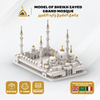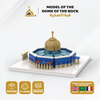In Islam, prayer (Salah) serves as a cornerstone of faith, a direct line of communication between an individual and Allah (SWT).
Introduction
Muslims perform Salah five times daily, fostering a rhythm of remembrance and devotion throughout the day. This practice not only strengthens one's spiritual core but also instills discipline, mindfulness, and a sense of community. Recognizing the pivotal role of prayer, nurturing a love for it within children becomes paramount in ensuring the well-being of future generations within the Muslim community.
Importance of Early Education:
Prophet Muhammad (PBUH) emphasized the importance of instilling good habits in children from a young age. Prayer, being a fundamental pillar of Islam, is no exception. Early exposure allows children to develop a natural affinity towards prayer, making it an integral part of their identity as they grow older. This not only fosters spiritual growth but also equips them with the tools they need to navigate life's challenges with faith and resilience.
Understanding Prayer in Islam:
The Five Pillars:
Islam is built upon five foundational principles known as the Five Pillars. Prayer (Salah) occupies the second pillar, signifying its central role in a Muslim's life. Performing Salah involves a series of postures and recitations that express submission and devotion to Allah (SWT).
Spiritual Connection:
Through Salah, Muslims connect directly with their Creator. The rhythmic movements, coupled with the recitation of Quranic verses, create a space for introspection and gratitude. This regular communication fosters a deep sense of peace, grounding individuals in their faith.
Teaching Approach:
Start Early:
There's no age too young to introduce children to the concept of prayer. Even infants can be exposed to the sounds of prayer calls (Adhan) and observe their parents performing Salah. As they grow older, they can begin to mimic simple movements like standing and bowing.
Simplified Understanding:
Break down the steps of prayer into age-appropriate chunks. Instead of overwhelming them with details, focus on the core message – expressing gratitude and connecting with Allah (SWT). Use relatable analogies, like talking to a loved one, to explain the purpose of prayer.
Practical Demonstration:
Children learn best by doing. Incorporate role-playing and hands-on activities to illustrate the different postures of prayer. Use colorful prayer mats and Islamic storybooks featuring relatable characters to make learning engaging and enjoyable.
Importance of Prayer for Children:
Spiritual Growth:
Prayer cultivates a sense of spirituality and mindfulness in children. The act of focusing on their connection with Allah (SWT) fosters a sense of inner peace and teaches them the importance of gratitude. Regular prayer also provides a foundation for developing a strong moral compass.
Moral Development:
The discipline required to perform prayer at specific times throughout the day instills valuable lessons in time management and self-control. Additionally, the humility inherent in bowing and prostrating teaches children respect and obedience to Allah (SWT) and, by extension, to their parents and elders.
Community Bonding:
Participating in congregational prayers at the mosque exposes children to a sense of belonging within the Muslim community. Seeing others pray together fosters a sense of unity and allows children to build positive relationships with their peers.
Further Read: Considering Conversion to Islam: A Guide for Beginners
Challenges and Solutions:
Distractions:
Children are naturally curious and easily distracted. Address this by creating a designated prayer space free from clutter and distractions. Keeping prayer times short and engaging can also help young children maintain focus.
Peer Influence:
Peer pressure can sometimes discourage children from practicing their faith. Openly discuss these challenges and foster a supportive environment at home where prayer is celebrated. Encourage children to find prayer buddies within their peer group for added support.
Parental Involvement:
Leading by Example:
Children learn best by observing the behavior of their parents. Regular and dedicated prayer habits within the family home set a powerful example for children. Let them see the joy and peace prayer brings to your life.
Encouragement and Support:
Celebrate your child's efforts, no matter how small. Positive reinforcement through praise and rewards goes a long way in motivating them to continue their prayer journey. Offer gentle reminders and be patient with their progress.
Incorporating Prayer into Daily Life:
Establishing Routine:
Create a consistent schedule for prayer within your child's daily routine. Integrate prayer times into existing routines like waking up or going to bed. This consistency makes prayer a natural and expected part of their day.
Making it Enjoyable:
Infuse prayer with joy and positivity. Play Islamic songs or stories about the importance of prayer. Let them choose their prayer outfit or decorate their prayer space. These small touches can make prayer make prayer a cherished part of their lives. Remember, the goal is to cultivate a love for prayer, not create feelings of burden or obligation.
Conclusion: Empowering Future Generations
By instilling a love for prayer in children, we are empowering future generations of Muslims to connect with their faith on a deeper level. Regular prayer fosters spiritual growth, moral development, and a sense of belonging within the Muslim community. These values serve as a strong foundation for navigating life's challenges and becoming well-rounded individuals.
The responsibility of nurturing young hearts and cultivating a deep-rooted connection to prayer lies not only with parents but also with the entire Muslim community. Masjids (mosques) can create dedicated children's prayer areas and organize interactive workshops on prayer. Islamic schools can incorporate age-appropriate prayer education into their curriculum. By working together, we can ensure that the call to prayer continues to resonate with future generations, reminding them of their connection to Allah (SWT) and guiding them on a path of righteousness.
Additional Tips:
Utilize Islamic Apps and educational websites that offer interactive games and quizzes related to prayer.
Encourage children to participate in Ramadan activities and Taraweeh prayers during the holy month.
Incorporate storytelling nights featuring Islamic tales that emphasize the importance of prayer.
Celebrate Islamic holidays like Eid al-Fitr and Eid al-Adha by making prayer a central part of the festivities.
Remember, the journey of guiding children towards prayer is a marathon, not a sprint. Be patient, celebrate their efforts, and most importantly, make it a joyful and enriching experience for them. By nurturing young hearts and fostering a love for prayer, we can empower future generations of Muslims to connect with their faith, build strong communities, and leave a positive impact on the world.








